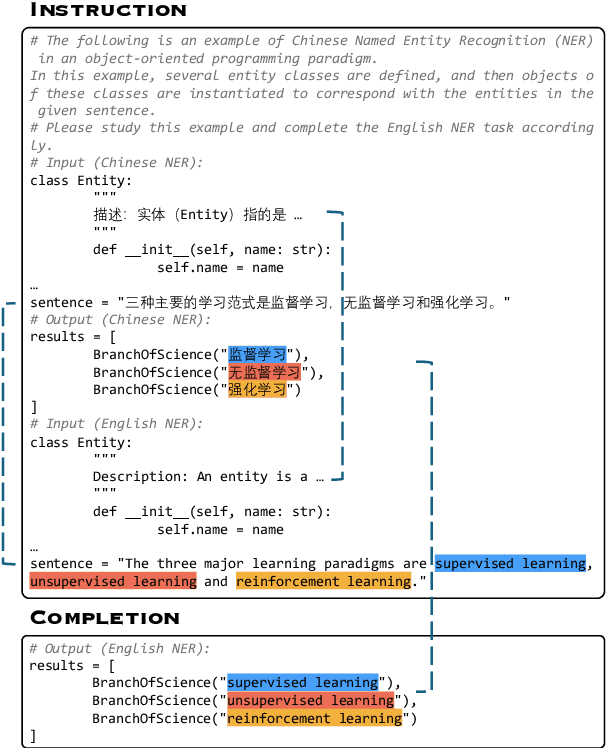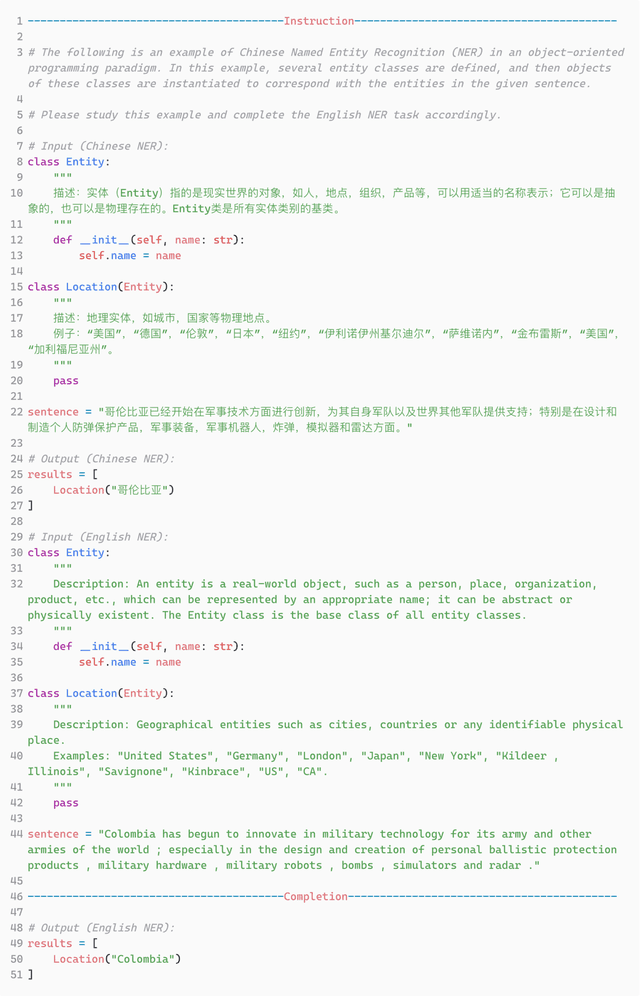Zixuan Li
Towards Robust Universal Information Extraction: Benchmark, Evaluation, and Solution
Mar 05, 2025Abstract:In this paper, we aim to enhance the robustness of Universal Information Extraction (UIE) by introducing a new benchmark dataset, a comprehensive evaluation, and a feasible solution. Existing robust benchmark datasets have two key limitations: 1) They generate only a limited range of perturbations for a single Information Extraction (IE) task, which fails to evaluate the robustness of UIE models effectively; 2) They rely on small models or handcrafted rules to generate perturbations, often resulting in unnatural adversarial examples. Considering the powerful generation capabilities of Large Language Models (LLMs), we introduce a new benchmark dataset for Robust UIE, called RUIE-Bench, which utilizes LLMs to generate more diverse and realistic perturbations across different IE tasks. Based on this dataset, we comprehensively evaluate existing UIE models and reveal that both LLM-based models and other models suffer from significant performance drops. To improve robustness and reduce training costs, we propose a data-augmentation solution that dynamically selects hard samples for iterative training based on the model's inference loss. Experimental results show that training with only \textbf{15\%} of the data leads to an average \textbf{7.5\%} relative performance improvement across three IE tasks.
Towards Event Extraction with Massive Types: LLM-based Collaborative Annotation and Partitioning Extraction
Mar 04, 2025Abstract:Developing a general-purpose extraction system that can extract events with massive types is a long-standing target in Event Extraction (EE). In doing so, the challenge comes from two aspects: 1) The absence of an efficient and effective annotation method. 2) The absence of a powerful extraction method can handle massive types. For the first challenge, we propose a collaborative annotation method based on Large Language Models (LLMs). Through collaboration among multiple LLMs, it first refines annotations of trigger words from distant supervision and then carries out argument annotation. Next, a voting phase consolidates the annotation preferences across different LLMs. Finally, we create the EEMT dataset, the largest EE dataset to date, featuring over 200,000 samples, 3,465 event types, and 6,297 role types. For the second challenge, we propose an LLM-based Partitioning EE method called LLM-PEE. To overcome the limited context length of LLMs, LLM-PEE first recalls candidate event types and then splits them into multiple partitions for LLMs to extract events. The results in the supervised setting show that LLM-PEE outperforms the state-of-the-art methods by 5.4 in event detection and 6.1 in argument extraction. In the zero-shot setting, LLM-PEE achieves up to 12.9 improvement compared to mainstream LLMs, demonstrating its strong generalization capabilities.
Audio-FLAN: A Preliminary Release
Feb 23, 2025Abstract:Recent advancements in audio tokenization have significantly enhanced the integration of audio capabilities into large language models (LLMs). However, audio understanding and generation are often treated as distinct tasks, hindering the development of truly unified audio-language models. While instruction tuning has demonstrated remarkable success in improving generalization and zero-shot learning across text and vision, its application to audio remains largely unexplored. A major obstacle is the lack of comprehensive datasets that unify audio understanding and generation. To address this, we introduce Audio-FLAN, a large-scale instruction-tuning dataset covering 80 diverse tasks across speech, music, and sound domains, with over 100 million instances. Audio-FLAN lays the foundation for unified audio-language models that can seamlessly handle both understanding (e.g., transcription, comprehension) and generation (e.g., speech, music, sound) tasks across a wide range of audio domains in a zero-shot manner. The Audio-FLAN dataset is available on HuggingFace and GitHub and will be continuously updated.
Robust Target Speaker Direction of Arrival Estimation
Dec 25, 2024Abstract:In multi-speaker environments the direction of arrival (DOA) of a target speaker is key for improving speech clarity and extracting target speaker's voice. However, traditional DOA estimation methods often struggle in the presence of noise, reverberation, and particularly when competing speakers are present. To address these challenges, we propose RTS-DOA, a robust real-time DOA estimation system. This system innovatively uses the registered speech of the target speaker as a reference and leverages full-band and sub-band spectral information from a microphone array to estimate the DOA of the target speaker's voice. Specifically, the system comprises a speech enhancement module for initially improving speech quality, a spatial module for learning spatial information, and a speaker module for extracting voiceprint features. Experimental results on the LibriSpeech dataset demonstrate that our RTS-DOA system effectively tackles multi-speaker scenarios and established new optimal benchmarks.
AlignXIE: Improving Multilingual Information Extraction by Cross-Lingual Alignment
Nov 07, 2024



Abstract:Empirical evidence suggests that LLMs exhibit spontaneous cross-lingual alignment. Our findings suggest that although LLMs also demonstrate promising cross-lingual alignment in Information Extraction, there remains significant imbalance across languages, revealing an underlying deficiency in the IE alignment. To address this issue, we propose AlignXIE, a powerful code-based LLM that significantly enhances cross-lingual IE alignment through two strategies. Firstly, AlignXIE formulates IE across different languages, especially non-English ones, as code generation tasks, standardizing the representation of various schemas using Python classes to ensure consistency of the same ontology in different languages and align the schema. Secondly, it incorporates an IE cross-lingual alignment phase through a translated instance prediction task proposed in this paper to align the extraction process, utilizing ParallelNER, an IE bilingual parallel dataset with 257,190 samples, generated by our proposed LLM-based automatic pipeline for IE parallel data construction, with manual annotation to ensure quality. Ultimately, we obtain AlignXIE through multilingual IE instruction tuning. Although without training in 9 unseen languages, AlignXIE surpasses ChatGPT by $30.17\%$ and SoTA by $20.03\%$, thereby demonstrating superior cross-lingual IE capabilities. Comprehensive evaluations on 63 IE benchmarks in Chinese and English under various settings, demonstrate that AlignXIE significantly enhances cross-lingual and multilingual IE through boosting the IE alignment.
Dictionary Insertion Prompting for Multilingual Reasoning on Multilingual Large Language Models
Nov 02, 2024Abstract:As current training data for Large Language Models (LLMs) are dominated by English corpus, they are English-centric and they present impressive performance on English reasoning tasks.\footnote{This paper primarily studies English-centric models, but our method could be universal by using the centric language in the dictionary for non-English-centric LLMs.} Yet, they usually suffer from lower performance in other languages. There are about 7,000 languages over the world, and many are low-resourced on English-centric LLMs. For the sake of people who primarily speak these languages, it is especially urgent to enable our LLMs in those languages. Model training is usually effective, but computationally expensive and requires experienced NLP practitioners. This paper presents a novel and simple yet effective method called \textbf{D}ictionary \textbf{I}nsertion \textbf{P}rompting (\textbf{DIP}). When providing a non-English prompt, DIP looks up a word dictionary and inserts words' English counterparts into the prompt for LLMs. It then enables better translation into English and better English model thinking steps which leads to obviously better results. We experiment with about 200 languages from FLORES-200. Since there are no adequate datasets, we use the NLLB translator to create synthetic multilingual benchmarks from the existing 4 English reasoning benchmarks such as GSM8K and AQuA. Despite the simplicity and computationally lightweight, we surprisingly found the effectiveness of DIP on math and commonsense reasoning tasks on multiple open-source and close-source LLMs.\footnote{Our dictionaries, code, and synthetic benchmarks will be open-sourced to facilitate future research.}
UncertaintyRAG: Span-Level Uncertainty Enhanced Long-Context Modeling for Retrieval-Augmented Generation
Oct 03, 2024



Abstract:We present UncertaintyRAG, a novel approach for long-context Retrieval-Augmented Generation (RAG) that utilizes Signal-to-Noise Ratio (SNR)-based span uncertainty to estimate similarity between text chunks. This span uncertainty enhances model calibration, improving robustness and mitigating semantic inconsistencies introduced by random chunking. Leveraging this insight, we propose an efficient unsupervised learning technique to train the retrieval model, alongside an effective data sampling and scaling strategy. UncertaintyRAG outperforms baselines by 2.03% on LLaMA-2-7B, achieving state-of-the-art results while using only 4% of the training data compared to other advanced open-source retrieval models under distribution shift settings. Our method demonstrates strong calibration through span uncertainty, leading to improved generalization and robustness in long-context RAG tasks. Additionally, UncertaintyRAG provides a lightweight retrieval model that can be integrated into any large language model with varying context window lengths, without the need for fine-tuning, showcasing the flexibility of our approach.
SemiDDM-Weather: A Semi-supervised Learning Framework for All-in-one Adverse Weather Removal
Sep 29, 2024Abstract:Adverse weather removal aims to restore clear vision under adverse weather conditions. Existing methods are mostly tailored for specific weather types and rely heavily on extensive labeled data. In dealing with these two limitations, this paper presents a pioneering semi-supervised all-in-one adverse weather removal framework built on the teacher-student network with a Denoising Diffusion Model (DDM) as the backbone, termed SemiDDM-Weather. As for the design of DDM backbone in our SemiDDM-Weather, we adopt the SOTA Wavelet Diffusion Model-Wavediff with customized inputs and loss functions, devoted to facilitating the learning of many-to-one mapping distributions for efficient all-in-one adverse weather removal with limited label data. To mitigate the risk of misleading model training due to potentially inaccurate pseudo-labels generated by the teacher network in semi-supervised learning, we introduce quality assessment and content consistency constraints to screen the "optimal" outputs from the teacher network as the pseudo-labels, thus more effectively guiding the student network training with unlabeled data. Experimental results show that on both synthetic and real-world datasets, our SemiDDM-Weather consistently delivers high visual quality and superior adverse weather removal, even when compared to fully supervised competitors. Our code and pre-trained model are available at this repository.
AgentCourt: Simulating Court with Adversarial Evolvable Lawyer Agents
Aug 15, 2024



Abstract:In this paper, we present a simulation system called AgentCourt that simulates the entire courtroom process. The judge, plaintiff's lawyer, defense lawyer, and other participants are autonomous agents driven by large language models (LLMs). Our core goal is to enable lawyer agents to learn how to argue a case, as well as improving their overall legal skills, through courtroom process simulation. To achieve this goal, we propose an adversarial evolutionary approach for the lawyer-agent. Since AgentCourt can simulate the occurrence and development of court hearings based on a knowledge base and LLM, the lawyer agents can continuously learn and accumulate experience from real court cases. The simulation experiments show that after two lawyer-agents have engaged in a thousand adversarial legal cases in AgentCourt (which can take a decade for real-world lawyers), compared to their pre-evolutionary state, the evolved lawyer agents exhibit consistent improvement in their ability to handle legal tasks. To enhance the credibility of our experimental results, we enlisted a panel of professional lawyers to evaluate our simulations. The evaluation indicates that the evolved lawyer agents exhibit notable advancements in responsiveness, as well as expertise and logical rigor. This work paves the way for advancing LLM-driven agent technology in legal scenarios. Code is available at https://github.com/relic-yuexi/AgentCourt.
Unifying Visual and Semantic Feature Spaces with Diffusion Models for Enhanced Cross-Modal Alignment
Jul 26, 2024Abstract:Image classification models often demonstrate unstable performance in real-world applications due to variations in image information, driven by differing visual perspectives of subject objects and lighting discrepancies. To mitigate these challenges, existing studies commonly incorporate additional modal information matching the visual data to regularize the model's learning process, enabling the extraction of high-quality visual features from complex image regions. Specifically, in the realm of multimodal learning, cross-modal alignment is recognized as an effective strategy, harmonizing different modal information by learning a domain-consistent latent feature space for visual and semantic features. However, this approach may face limitations due to the heterogeneity between multimodal information, such as differences in feature distribution and structure. To address this issue, we introduce a Multimodal Alignment and Reconstruction Network (MARNet), designed to enhance the model's resistance to visual noise. Importantly, MARNet includes a cross-modal diffusion reconstruction module for smoothly and stably blending information across different domains. Experiments conducted on two benchmark datasets, Vireo-Food172 and Ingredient-101, demonstrate that MARNet effectively improves the quality of image information extracted by the model. It is a plug-and-play framework that can be rapidly integrated into various image classification frameworks, boosting model performance.
 Add to Chrome
Add to Chrome Add to Firefox
Add to Firefox Add to Edge
Add to Edge